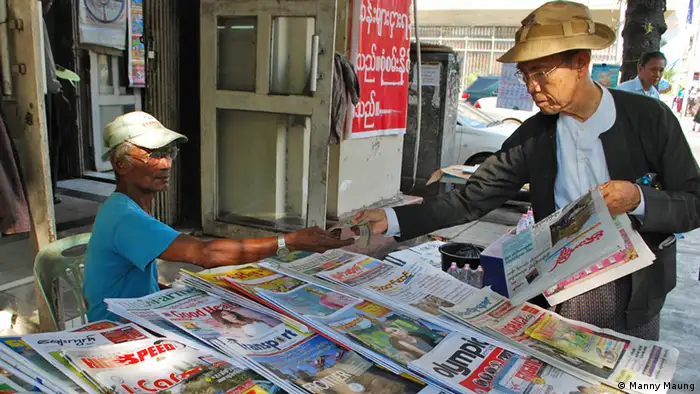Insights
A newspaper hawker's take on the media
A street newspaper seller in Myanmar gives his personal view of this country's flourishing newspaper scene, as part of a #mediadev series on what people around the world think of media.
Early every weekday morning, U Myo catches a ferry north from the rural township of Dalat, across the river to Yangon, Myanmar's former capital and largest city.
He makes his way to the wholesale newspaper market in downtown Merchant Street to buy freshly printed daily papers along with a bundle of different weeklies. Picking the ones that he knows will sell best, he trundles them off by rickshaw to another downtown corner of pavement.
U Myo then sets up his own newspaper stand at a busy intersection that's perfect for catching the eye of a wandering passerby or even a disgruntled passenger on a bus or taxi stuck in the heavy Yangon traffic.
In between customers, 60-year-old U Myo reads voraciously. He sells both English and Burmese-language press, and while he can't read the English-language newspapers and magazines he sells, U Myo still pages through them.
"I spend time reading where I can," U Myo says. "Really, I'm reading all day."
After decades of military rule, Myanmar has recently transitioned to a more open model of government. A quasi-civilian government came into power in 2011 and subsequently lifted many wide-ranging restrictions, including easing censorship of print media in 2012.
The result was a burgeoning newspaper industry, with several privately owned Burmese-language daily papers entering what had been a state-dominated market.
The 2015 general elections in November saw democracy icon, Aung San Suu Kyi's National League for Democracy party take sweeping wins across the country. Hope has been reinvigorated among the populace and U Myo says the changes are palpable.
"It is much more open now," U Myo explains. "There are so many topics and issues that we can read and learn about that were never allowed openly before."
Although he is cautiously optimistic, he remains wary of the changes and takes care to exchange notes with his friends about the details of events described in the newspapers he reads.
"We have to listen and watch and read everything to make sure we feel like we are being given the right information," he says.
U Myo says he is not partial to any one newspaper, preferring to follow up on what is leading the day's headlines while comparing the contents of one paper with another to get the most rounded coverage. "Sometimes people criticize the journalists for not including everything but I do think it also depends on what information that journalist can get on the day," he says.
U Myo points to a cover story about Aung San Suu Kyi on one of the newspapers on his stand, "Democracy Today". He recalls how prior to 2012, placing a picture of the Nobel Peace Laureate in the paper, let alone on the front cover, would have landed the editor in prison.
"The challenge is to keep improving," U Myo says. "Hopefully things remain on track and don't go backwards."
Media Situation in Myanmar
A 2015 report by PEN America, "Unfinished Freedom: A Blueprint for the Future of Free Expression in Myanmar" draws attention to the continued gaps in the right to exercise freedom of expression in Myanmar.
The report highlights how censorship is still enforced through the Armed Forces Accurate Information team, which has issued warnings on the portrayal of perceived criticisms towards the Myanmar government and its armed forces. The recent imprisonment of activists, threats towards journalists and lengthy trials of student activists suggest that old junta habits are still at play.
Difficulties in accessing information mean media practitioners can't do their jobs properly, resulting in unbalanced articles that are often short on details. And while there may have been a lifting of censorship and ownership of print media in 2012, radio and television remain dominated by state-owned outlets with heavy censorship of content.
Ethnic media is also under pressure, with few resources made available for language-specific content. Access to media has certainly improved for some, but many people still lack computer or language literacy and so are unable to access media such as blogs and websites.
With respect to media development, there is significant concern that online hate speech has fueled race-related communal violence in Myanmar. Vitriolic hate speech calling for the killing of ethnic Rohingya and Muslims has proliferated, with little done by government moderators to allay tensions. "Freedom of speech" has been used in this context to excuse hate speech.
DW recommends
WWW links
- Date 27.07.2016
- Author Manny Maung
- Feedback: Send us an e-mail. Please include your name and country in your reply.
- Print Print this page
- Permalink https://p.dw.com/p/1JWTz
- Date 27.07.2016
- Author Manny Maung
- Send us your feedback.
- Print Print this page
- Permalink https://p.dw.com/p/1JWTz

